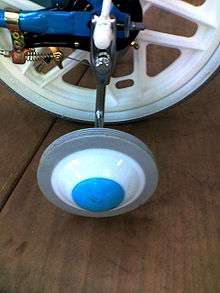Training wheels

Training wheels (or stabilisers in British English) are an additional wheel or wheels mounted parallel to the rear wheel of a bicycle that assist learners until they have developed a usable sense of balance on the bicycle. Typically they are used in teaching very young children to ride a bike, although versions for adults exist.
Learning to bicycle
Training wheels that prevent the bike from leaning also prevent countersteering, so that, as with a tricycle, children learn to turn the handlebars the wrong way, which must be unlearned later.[1] Sheldon Brown wrote that training wheels can become an obstacle to learning if they are adjusted incorrectly, because they prevent the bike from leaning if they are too low, and can inhibit braking if too much weight is taken off the rear wheel by training wheels that are too low.[2] Adjusting training wheels correctly, and raising them higher as the child's skill increases, avoids these problems.[2] Alternatives to using training wheels include removing the pedals from a child's bike, or balance bicycles.[3][4]
See also
References
- ↑ Heine, Jan (February 2011), "Cornering on a Bicycle; Master centrifugal force on curves" (Adobe PDF), Adventure Cyclist, retrieved 2011-06-07
- 1 2 Brown, Sheldon (3 May 2010), Teaching Kids To Ride, retrieved 2011-06-07
- ↑ Athavaley, Anjali (1 September 2010), "Look Ma, No Pedals! --- Ditch the Training Wheels, New Bikes Promise a Faster Way to Learn", Wall Street Journal, New York, NY: ProQuest, p. D.1
- ↑ Kolpack, Dave (7 June 2010), "South Dakota man sells training bikes for tykes", Bloomberg BusinessWeek, Rapid City, South Dakota, retrieved 2011-06-07 Associated Press
